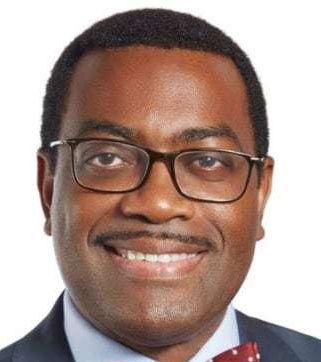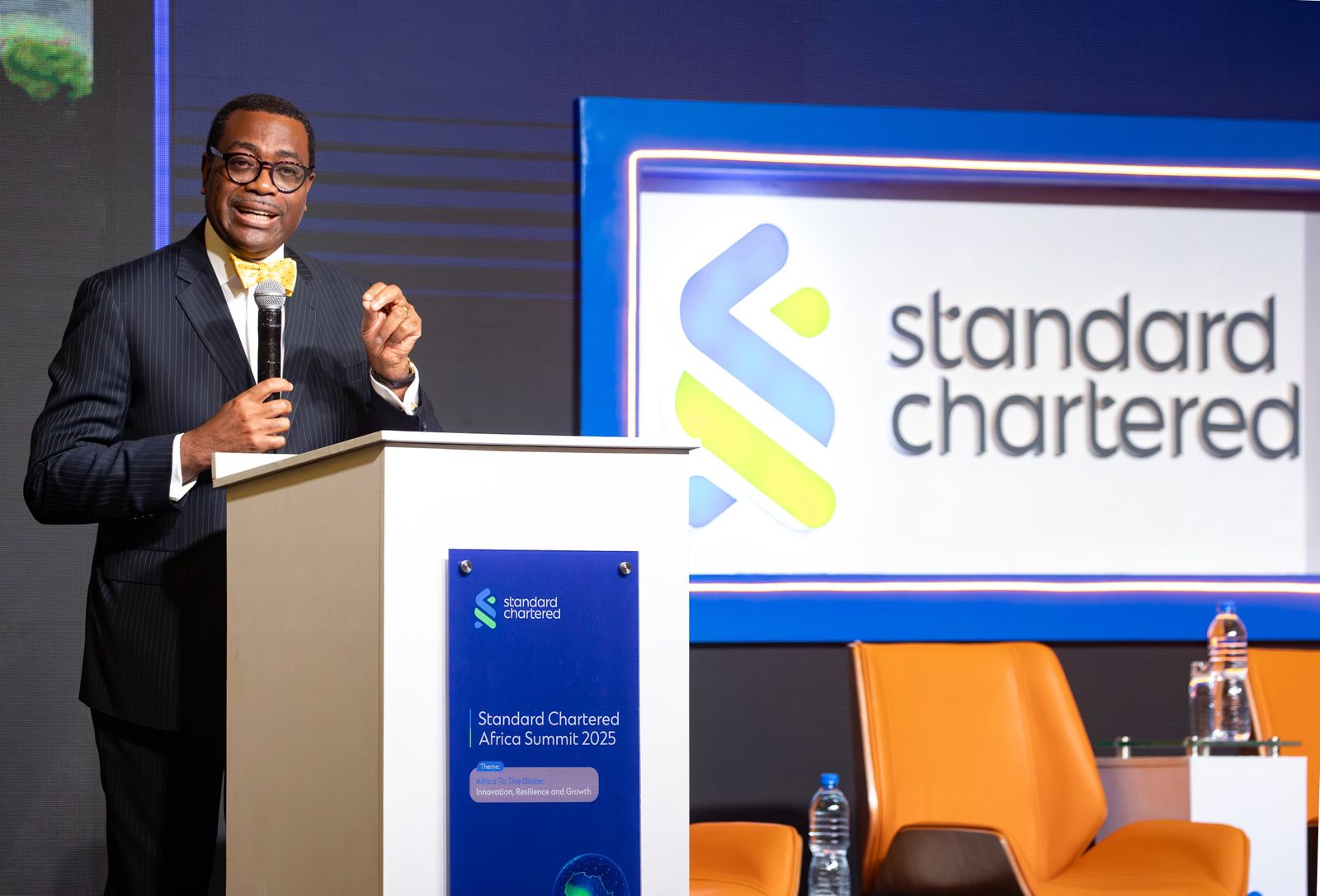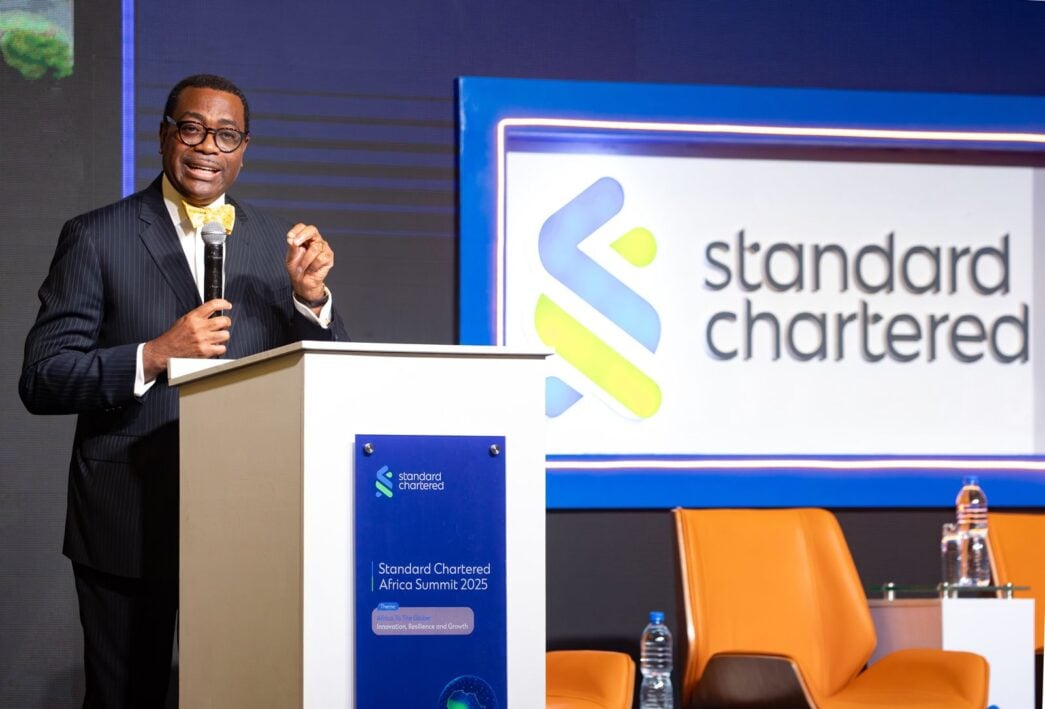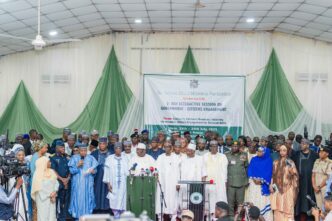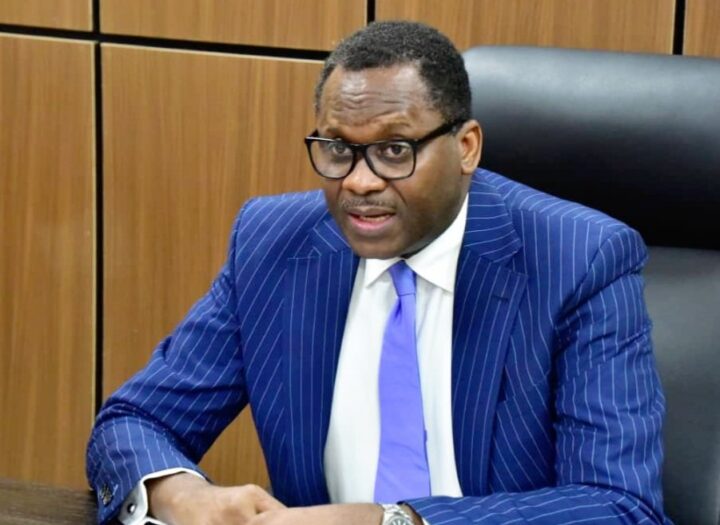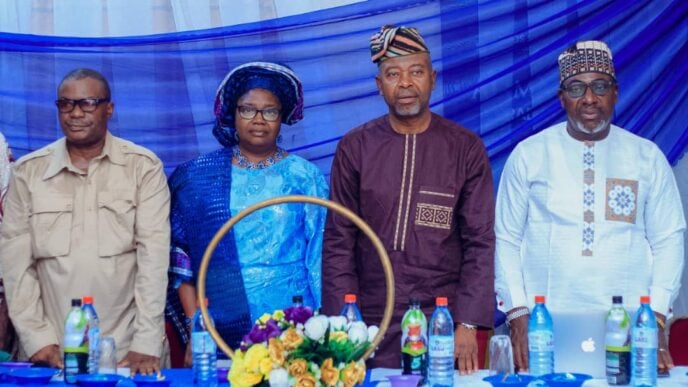Dear friends, colleagues and partners with Africa, I wish to thank you for inviting me to speak at the Standard Chartered Bank Africa Summit. When I was approached to consider delivering the keynote speech, I did not hesitate. How can someone known as “Africa’s Optimist in Chief” not accept to speak on Africa!
I am therefore delighted to be here today and to see several old faces, friends and colleagues that I have worked and interacted with in Africa and globally over my ten years as President of the African Development Bank.
I wish to start by congratulating the Standard Chartered Bank for being named the Best Transaction Bank at the Asset Triple A Treasurise Awards in Hong Kong last month. Your record breaking 127 accolades reflects an exceptionally strong track record of excellence in banking and finance, globally.
Standard Chartered Bank has very deep roots in Africa, starting with its early days as the Standard Bank in 1862 and then later its establishment as Standard Bank of South Africa. With several decades of your investing in Africa, from retail to commercial banking and investment banking, the reach of Standard Chartered Bank is wide across Africa.
Advertisement
Today, with presence in 53 countries and 165 years of history in Africa, Standard Chartered Bank has become an indispensable Bank for the acceleration of the growth and development of African economies.
While it has sold down several of its retail banking operations, with many of them bought by Access Bank Holdings, while shifting its focus more towards areas of comparative advantage in commercial banking, investment banking, corporate finance and wealth management, Standard Chartered Bank will continue to be strategic for financing Africa’s growth.
I am delighted that as I end my term as President of the African Development Bank on September 1, 2025, I have this opportunity to share with the Standard Chartered Bank’s Africa Summit some of my reflections on Africa.
Advertisement
I will therefore be speaking to you today on “Tilting Global Capital for Unlocking Investment Opportunities in Africa”.
The speech is organized into 5 major sections.
In the first part, I will review Africa as an investment proposition. In the second part I will discuss some priority areas to deploy investments. In the third part, I will discuss attracting global capital, from private equity, venture capital and institutional investors. In the fourth part, I will discuss the issue of risks to investment and how to mitigate them. In the fifth part, I will discuss the role of multilateral development banks in supporting the tilting of global capital to Africa.
I will then conclude with some recommendations for action.
Advertisement
Africa as an investment proposition is very strong. With improvements in macroeconomic and fiscal environment, and spurred by increased public investment and consumption, the continent is witnessing rapid economic growth.
Africa’s economic growth is projected to rise from 3.3% in 2024 to 3.9% in 2025, and to 4.0% in 2026. Defying all odds, 21 African countries are expected to exceed 5% growth in 2025, with some even exceeding 7%. Africa accounts for 12 out of the 20 fastest growing economies in the world in 2025.
However, the GDP growth rate on a per capita basis still falls way short of what is needed to achieve quantum leaps in inclusive growth and prosperity for its 1.4 billion people.
That is why the African Development Bank launched its High 5 strategic programs ten years ago: to Light up and power Africa; Feed Africa; Industrialize Africa; Integrate Africa; and Improve the Quality of Life of the people of Africa.
Advertisement
I am delighted that in the past ten years under my Presidency, the High 5s of the African Development Bank impacted on the lives of over 565 million people.
To achieve the United Nations Sustainable Development Goals by 2030, Africa needs massive investments in infrastructure, energy, digital connectivity, roads and transport, social sectors including health, education, water and sanitation, as well as human capital. To achieve this the continent will need at least $1.3 trillion per year in financing. This will require the mobilization of capital at several levels, including from domestic resources mobilization, capital markets, private sector investments, concessional finance, and foreign direct investment.
Advertisement
Africa must attract global capital at scale. This is urgent given the rapid scaling back of traditional aid flows and lower concession financing flows and the direct and indirect effects of the US tariffs on export revenues and foreign exchange reserves.
To achieve faster and more stable economic growth, Africa must move away from aid to investment to unlock its vast assets.
Advertisement
And Africa has all it takes to achieve this bold ambition.
Africa is the world’s most significant growth frontier for several reasons.
Advertisement
First is its rapid population growth, with the world’s largest youth population, which will spur increased consumption of goods and services. The size of Africa’s consumer market is projected to increase from $1.4 trillion in 2015 to over $2.5 trillion by 2030.
Second, Africa is critical for feeding the world, as 65% of the uncultivated arable land left to feed the world being in Africa. So, what Africa does with its agriculture will determine the future of food in the world.
The size of the food and agriculture market in Africa is estimated to rise to $ 1 trillion by 2030. Vast opportunities exist for agribusinesses and Agri-tech companies to apply digital tools to raise productivity and incomes. Equally vital is expanding their access to digital services. A powerful example is the Mobilizing Access to Digital Economy, a collaborative effort between the African Development Bank and Mastercard, to reach 300 million farmers with digital access to information, markets and finance.
Third, with Africa accounting for 30% of all mineral reserves globally and huge shares of critical minerals such as cobalt (77%), platinum (80%), manganese (51%), the continent will shape the future of global energy transition, and the future of manufacturing of electric vehicles, mobile phones, computers and defense systems. The rising and intense geopolitical justling to access these critical minerals is already shaping global geopolitics in Africa.
Fourth, Africa’s rapid urbanization puts the continent at the forefront of urban markets globally. Estimates show that 21 out of the 30 fastest growing cities in the world by 2035 will be in Africa. This will further drive demand for infrastructure, especially energy, water, sanitation, transport, and urban housing. Africa will need about $2.1 trillion to meet the rising demand for urban housing.
Fifth, the African Continental Free Trade Area, with an estimated market size of $3.4 trillion, will be the largest free trade zone in the world in terms of the number of countries. The potential of the zone will be more immense if it develops into an industrial manufacturing zone.
Africa offers high rate of returns to investment.
Don’t believe me, believe the data. The United Nations Development Program’s recent Africa Investment Insights show that investing in Africa gives Internal Rates of Returns of between 15 and 25 percent.
How about confidence of investors?
Don’t believe me, believe the data.
A survey by the Africa Venture Capital Association indicates that 62% of the Africa-based limited partners see Africa as more attractive than other emerging markets, a view also expressed by 40% of international limited partners. In addition, more than 90% of the limited partners surveyed planned to accelerate or maintain the pace of their capital allocation to Africa over the next three years, showing continued and sustained interest.
The flow of capital to Africa, however, has not matched its huge potential compared to other emerging markets. According to UNCTAD, while foreign direct investment flows to Africa reached an all-time high of $94 billion in 2024, a 75% increase from the previous year, this represents 6% of global FDI flows. There is still lots of scope to expand FDI inflows into Africa given its huge needs.
Opportunities for investment to attract global capital are immense in Africa. I would like to touch on energy, agriculture, mining, digital economy, manufacturing and infrastructure.
Energy: Bridging Africa’s massive energy deficit, with 600 million people without access to electricity is a huge investment opportunity.
Africa has some of the world’s largest renewable energy sources, including solar (11 Terawatts), hydro (350 gigawatts), wind (150 gigawatts), and geothermal (15 gigawatts). Unlocking these potentials will power massive industrial development for the continent, allowing it to be more competitive and expand value addition to its vast agricultural commodities, minerals and metals.
The African Development Bank and the World Bank’s jointly launched Mission 300 has as goal to connect 300 million people to electricity by 2030. This requires public and private sector investments. The Energy Compacts for the first 12 countries totals $127 billion with over $61 billion expected from the private sector.
Agriculture: Investments are needed to unlock the agricultural potential for the continent, especially for value addition to agricultural commodities. Achieving this requires the development of industrial platforms that will allow the continent to move up the agricultural value chains.
The African Development Bank is investing massively in the development of Special Agro-industrial Processing Zones across Africa, enabled with infrastructure to support the establishment of industries to process and add value across a wide range of agricultural products.
The African Development Bank has committed over $934 million towards the development of the special agro-industrial processing zones. We have mobilized co-financing of $938 million from partners, including the International Fund for Agricultural Development, the Islamic Development Bank, Japan International Cooperation Agency, and the West African Development Bank.
We have also launched together with partners, the Alliance for Special Agro-Industrial Processing Zones to accelerate the development of these zones across Africa, with $3 billion in commitments.
The development of the special agro-industrial processing zones is ongoing in 27 sites across 11 countries.
I am pleased that in Nigeria, the African Development Bank and its partners have supported the launch of the special agro-industrial processing zones in the first 8 States of the Federation (Ogun, Oyo, Cross Rivers, Imo, Kaduna, Kwara, Kano) and the Federal Capital Territory. The African Development and partners have already mobilized $2.2 billion to implement the phase two of the special agro-industrial processing zones to expand into 24 more States in Nigeria.
Mining: Investments are needed to unlock the massive opportunities in the mining sector, especially for value addition and beneficiation. This will require financing for minerals processing zones, infrastructure, establishment of industries to process and add value, backed by regulations that enforce transparency, natural resource governance and environmental sustainability.
The African Development Bank is investing $500 million towards the development of the Lobito corridor, a railways corridor to link the mining areas of Angola to the Democratic Republic of Congo, Zambia and Tanzania.
The African Development Bank is also the mandated lead arranger for and mobilizing $3.2 billion for the construction of the standard gauge linking the mineral rich areas of Tanzania and Burundi.
Last year, the African Development Bank provided $150 million senior loan to Mauritania’s national mining company to double the transport capacity of its iron ore railways.
To maximize benefits from its abundant minerals and metals, Africa must end the export of raw minerals and metals and establish processing facilities to allow it to capture higher share of the value, create jobs and support local businesses through skills and technology transfer via local content laws.
For example, the establishment of processing facility for lithium-ion precursor batteries in the Democratic Republic of Congo is three times less expensive than in the United States of America, Poland and China.
Digital economy: Investments should also target the rapidly developing digital market in Africa, especially with the growth of Fintech, mobile banking and digital payment systems that are transforming the financial services landscape, as well as financial inclusion. The rapid expansion of the digital economy will add $180 billion to Africa’s GDP by 2025, and $712 billion by 2050.
Africa accounts for half of the 1.6 billion global money accounts, 74% of the global transaction volume, and 68% of the $1.2 trillion transaction value. Africa’s startup ecosystem is taking advantage of the digital economy with more than 600 active startup hubs on the continent.
The African Development Bank estimates that artificial intelligence will contribute $ 1 trillion annually to Africa’s productivity by 2030. Massive investments will therefore be needed in artificial intelligence, big data, blockchains, drones, additive manufacturing and data centers.
Manufacturing: To deploy capital at scale, African global corporates should be strongly supported with financing at scale to establish global industrial platforms that will support Africa to be dominant players in critical areas in which it has comparative advantage.
A good example is the case of Dangote Petrochemicals Complex which at $24 billion, is now supplying petroleum and petrochemicals to the Nigerian market, other African and global markets.
Another example is the $20 billion Liquified Natural Gas project in Mozambique, the largest foreign direct investment when it was structured.
These examples show that Africa can attract global capital for large and globally competitive industrial platforms.
Other large corporates that signal Africa’s business viability and profitability in tilting global capital to Africa includes Goldfield Limited (Market cap: $ 17.46 billion), Naspers (market cap: $14.56 billion), Vodacom Group (market cap: $12.47 billion), MTN Group (Market cap: $10.99 billion) and Anglo American ($9.39 billion).
Infrastructure: Africa needs investments to develop world-class infrastructure, from highways to airports, seaports, speed trains, at attractive and competitive rates of return. That is why in the past ten years the African Development Bank has invested over $55 billion in infrastructure, making it the largest investor in infrastructure in Africa.
To further promote market-based platforms for developing infrastructure, the African Development Bank established Africa50, for project development and project finance, to deliver market rates of return. Africa50 is becoming one of most diversified asset managers in the infrastructure space with verticals in project development, early-stage equity investments, private equity funds and mezzanine funds.
To ensure the development of pipelines of bankable green infrastructure projects, the African Development Bank developed the Alliance for Green Infrastructure in Africa (AGIA), supported by the G7, to mobilize $10 billion for building climate resilient green infrastructure in Africa.
To attract more financing into infrastructure, public-private partnerships should be expanded. Also needed are vehicles for preparing bankable project pipelines. In addition, the use of instruments such as asset recycling of brownfield infrastructure assets can attract investors due to existence of streams of revenue, as opposed to investing in the early project development phase which is riskier.
To attract global capital into Africa infrastructure asset it is also important to move from the current approach on infrastructure financing, from originating to hold to originating to distribute. This will ensure the development of secondary markets to exit infrastructure investments using the capital markets.
I would now like to turn to the role that private capital, including private equity funds, venture capital funds and institutional capital can play.
Private equity: Private equity firms are showing long-term confidence in African markets. Private equity fundraising in 2024 saw an increase to $4 billion, compared to $1.9 billion in 2023, an impressive 117% surge.
In 2024, private equity also demonstrated resilience in a complex macroeconomic environment, recording 485 deals valued at $5.5 billion. This contrasts with the Global Private Equity fundraising decline by 20% in the US, 13% in Europe and 20% in Asia.
In the Venture Capital space, African startups continue to demonstrate resilience and quality global competitiveness at the later funding stages. At the Series B and Series C stages, African startups posted median deal sizes of $29 million and $38 million, respectively, surpassing the global average of $21 million for Series B and $35 million for Series C.
Most of the venture capital funds are however concentrated in only few countries: South Africa, Nigeria, Kenya and Egypt. Some of the companies supported by venture capital funds have been successful, with about seven of them as unicorns. However, private and venture capital funds in Africa still represent but a fraction of the global private equity and venture capital funds.
To expand the growth of these funds it will be critical to improve exits for investors, develop and deepen domestic capital markets, expand the listings of small and medium sized businesses through IPOs, the establishment of small and medium-sized equity boards on stock exchanges, improved regulatory environment and investor protection. Also important is the development of business incubators and accelerators to provide a strong ecosystem of support to entrepreneurs, and overall improvement in the business environment, including the ease of establishing businesses and capital gains repatriation.
Investment Banks: Investment Banks will also play important roles in the tilting of global capital to Africa, for governments and for the private sector. The rising need for financing by governments and the low interest rate environment for several years in developed economies spurred countries in Africa to issue debt securities on the global markets. Investment Banks provide advisory services and support the issuances of the securities.
In more mature markets, investment banks support companies to raise capital through equity securities. According to estimates by Research and Markets (2025), the size of global investment banking increased from $139.86 billion in 2014 to $151.01 billion in 2025 and is projected to reach $203.6 billion in 2029.
The size of Africa’s investment banking market is estimated at $7.37 billion in 2025 or 3.61% of the global investment banking. In particular, the ‘bulge bracket’ market investment banks have limited regulatory footprint in Africa.
However, vast opportunities exist for investment banks as the African Continental Free Trade Area deepens, and as companies expand operations across borders requiring cross-border payment systems, risk and portfolio management, restructuring and consolidation of firms and investment flows. Investment Banks will be able to help structure transactions across markets, including for mergers and acquisitions, divestitures, leveraged buyouts and in mature markets to support corporates with issuances of IPOs to mobilize capital to support business expansion to take advantage of opportunities.
Institutional capital: Globally, institutional capital is massive, reaching $128 trillion of Assets Under Management (AUM) in 2024, according to Boston Consulting Group. The size of the institutional capital in Africa, with pension funds, sovereign wealth funds and insurance pool of funds, is estimated at $2 trillion. If Africa is able to tilt just 1% of the global assets under management it would attract $1.28 trillion, which will be all it needs to meet all its investment needs to achieve all of its Sustainable Development Goals.
Institutional investors facing capital allocation decisions will want to see bankable projects with sufficiently high risk adjusted returns. Developing large pipelines of such bankable projects is challenging, although progress is being made, such as through Africa50 and other infrastructure funds. Risks will need to be reduced, including project and market risks, and political risk.
Global investors will also be looking into the move of domestic institutional investors investments. In this regard, Africa50’s Africa’s Infrastructure Acceleration Fund success in securing first close at $222 million with the participation of 16 African institutional investors, represents a major milestone for African institutional investors.
That is also why the African Development Bank, through its Capital Markets Development Fund is supporting the deepening of Africa’s domestic bond markets. A deeper financial market will allow institutional investors, local and international, to invest in Africa’s infrastructure bonds, corporate bonds or other vehicles.
Tilting global institutional investors will also require multiple efforts, including improved business, legal and regulatory environment, improvement in rule of law and contract enforcement, harmonizing financial regulatory and investment frameworks across countries, and well trusted investment platforms that support investors.
I would now like to address a major issue confronting the flow of capital to Africa: that of risk.
The flow of global capital to Africa is influenced by the assessment of risk of investing in the continent. African countries pay 3-5 times more to access capital than other parts of the world, due to unfair risk assessments by credit rating agencies.
This ‘Africa risk premium’ costs Africa $75 billion annually in debt service costs, according to the United Nations Development Program. An IMF study shows that African governments pay an average of 50 basis points above global peers during “normal times” and up to 120 basis points during periods of global stress, simply for issuing the securities from Africa.
That is why the African Development Bank supports the establishment of the Africa Credit Risk Agency to properly assess Africa’s risk.
However, the Moody’s Analytics report on the cumulative losses to infrastructure globally shows that losses in Africa are 1.9%, compared to 6.6% in North America, 10.4% in Latin America, 12% in Eastern Europe, and 4.6% in Western Europe and Asia.
So, Africa is the least risky in terms of investing in infrastructure.
The availability of hedging instruments can help with mitigating risk since institutional investors will be providing capital in foreign currencies while revenues will be in local currencies. To reduce the currency risk facing investors several instruments can be used, including FX options, forward contracts, currency swaps and interest rate swaps.
In addition, hedging offerings include derivatives such as synthetic local currency loans, or the use of external platforms such a TCX which offers over the counter instruments to hedge currency and interest rate risks in markets where long term hedging or markets do not exist.
There are several instruments available for reducing risks to capital investment in Africa. The African Development Bank, relying on its AAA global credit rating, provides partial credit and partial risk guarantees to de-risk financing. These have been very successful in leveraging private capital investments, as well as supporting sovereigns to access global capital markets with lower coupon rates, while securing longer maturities for their debt securities.
Since 2019, the African Development Bank has approved 16 partial credit and partial risk guarantees valued at close to $3 billion, mobilizing $ 5 billion for the continent.
The African Development Bank’s $250 million partial credit guarantee allowed Egypt to raise $500 million Panda bond, the first ever by an African country on the Chinese capital market.
The Standard Chartered Bank participated as the sole lender in the 2023 Cote d’Ivoire’s sustainable loan partial credit guarantee transaction. The African Development Bank was able to unlock 533 million euros from the Standard Chartered Bank in support of the country’s financing needs.
The guarantee allowed Standard Chartered Bank to extend the tenor of the loan and optimize its pricing in support of Africa’s development. I am delighted that this transaction was awarded the Sovereign Loan Deal of the Year at the lender’s conference on Bonds and Loans in Cape town.
I would now like to discuss the roles that multilateral development banks can play in addressing some of these challenges to mobilizing capital.
Multilateral Development Banks have the Global Emerging Markets (GEMS) Risk Database which can help to better assess the risk of lending to sovereigns and private sector in Africa. The GEMS Risk Database, originally developed by the International Finance Corporation (IFC) and the European Investment Bank, an exclusive frontier emerging market database, covers 30 years of data on defaults and recovery statistics from multilateral development banks.
Its development was borne out of the observation that credit rating agencies have relatively little data on emerging and frontier markets, as the ratings universe is skewed towards developed markets.
The GEMS reports, which covers private and public lending and sovereign and sovereign guaranteed lending, can be used to complement the rating agency data pools to inform a better assessment of risk. The GEMs database shows that the risk of default in emerging markets, including Africa, are within the boundary of what global capital allocators face elsewhere.
The African Development Bank also plans to establish the African Risk Mitigation Agency (ARMA) which will pool all the risk mitigating instruments of the Bank into one separate and independent entity. This will cover equity risk, refinancing risk, climate risk and political risk insurance.
Concessional financing is very vital to provide blended finance to lower the cost of capital and to reduce risks through the issuance of guarantees to investors. Over the ten years the African Development Bank provided over $102 billion in low-cost financing to Africa.
Under my Presidency at the Bank, we succeeded in raising the capital of the Bank from $93 billion to $318 billion, the highest in the history of the Bank since its establishment in 1964. Maintaining the Bank’s AAA credit ratings by the major global credit ratings agencies for the past decade has allowed the Bank to issue long term debt instruments, under its sustainable bond framework, including social, green and sustainability bonds.
Since the initiation of the Bank’s Social Bond Issuance Framework in 2023, the African Development Bank has risen to the top of the rankings of social bond issuance by multilateral development banks, issuing a total of $14 billion of social bonds in the past eight years. The African Development Bank has been a long-term issuer of global benchmark bonds in US dollars and more recently in Euros market. This allowed the Bank to raise $10 billion in 2025 alone to finance projects across the continent.
The African Development Bank is not just waiting for more capital, we are innovating to do more with the capital we have. Through our balance sheet optimization initiatives, we are stretching every dollar of risk capital further. Our ambition is threefold: free up capital, crowd in investors and amplify development impact.
These instruments have included the first-ever synthetic securitization of a non-sovereign portfolio by a multilateral development bank, transferring the mezzanine risk of a $ 1 billion portfolio of private sector loans to investors such as Africa50 and Newmarket.
In 2022, we broke new ground with the Room to Run Sovereign deal, structuring a $2 billion synthetic risk transfer that mobilized $400 million first loss from a panel of private insurers and $1.6 billion in guarantees from the UK’s Foreign, Commonwealth and Development Office. The Room to Run Sovereign offering created an estimated $2 billion in new sovereign lending headroom, while also improving some of the African Development Bank’s key prudential metrics.
The African Development Bank broke new ground again last year with the execution of its first ever private sector hybrid capital transaction by a multilateral development bank. The $750 million hybrid capital was a huge success, with over 275 investors participating with a book order of $5.1 billion, the largest ever book order achieved by the African Development Bank.
Perhaps the most transformative instrument for titling more global financing to Africa’s development is the rechanneling of the IMF’s Special Drawing Rights (SDRs) to multilateral development banks.
This effort, spearheaded by the African Development Bank in partnership with the Inter-American Development will allow the use of the rechanneled SDRs as hybrid capital, which can be leveraged by 4-8 times.
For example, a $20 billion in rechanneled SDRs will translate into up to $160 billion in new global financing that can be delivered to Africa.
In today’s environment with declining aid, the rechanneling of the SDRs for use as hybrid capital is transformational. It will be at zero costs to taxpayers in the countries allocating their SDRs.
As a perpetual hybrid capital instrument, it can be used to leverage the AAA credit rating of multilateral development banks to deliver financing at greater scale for developing countries, especially Africa.
The Africa Investment Forum, a strategic partnership initiative of the African Development Bank with its coalition of eight founding partners, is also changing how capital is mobilized for Africa’s development. This fully transactional platform for projects has become the continent’s premier investment marketplace, where bankable projects meet with serious investors and deals are accelerated to financial closure.
With a sharp focus on deal origination, structuring and execution, the Forum has already mobilized over $225 billion in investment interest across critical sectors such as infrastructure, energy, agribusiness and manufacturing.
African Development Bank, over the past ten years, has transformed itself into a global financial institution with reputation and capacity to help tilt global capital to Africa. It is Africa’s only financial institution with AAA credit ratings, which under my leadership we maintained for the past ten years.
The African Development Bank was ranked by Global Finance as the Best Multilateral Financial Institution in the World.
The concessional financing institution of the bank – the African Development Fund – was ranked as the second-best concessional financing institution in the world, ahead of all 55 concessional financing institutions in all OECD countries.
The African Development Bank, for two consecutive years, has been ranked as the Most Transparent Financial Institution in the World, by Publish What You Fund, and this year scored 98.8% on the index, the highest ever in the history of the global financial transparency index.
I am proud to be leaving behind a global financial institution that will be able to work with global partners, powered by financial and institutional innovations, to further tilt global capital to Africa.
Global corporate and investment banks, including Standard Chartered Bank, can partner with the African Development Bank, in strategic ways on “Tilting global capital for unlocking investments in Africa”.
First, through their greater use of fairly priced multilateral development banks’ AAA rated risk mitigation and credit enhancement instruments to deliver affordable interest rates and tenor extension to your corporate clients.
Second, through greater innovation on instruments to channel regional and global capital to infrastructure and productive sectors.
Third, by mainstreaming best practices on Environmental, Social and Governance (ESG) and climate proofing into your corporate clients’ portfolio.
Fourth, by developing co-Mandated Lead Arranger opportunities to jointly deliver best solutions for your corporate clients.
Fifth, through collaboration on the deepening domestic capital markets and scaling up local currency financing solutions.
To conclude, it is clear that Africa is a profitable investment destination with vast opportunities for investors. The continent has demonstrated incredible resilience, and its future will be powered even more with financial innovations and strategic partnerships to tilt more global capital to the continent. Titling more global capital to Africa will require greater efforts on several fronts.
First, a more stable macroeconomic and fiscal environment as well as more predictable regulatory environment for investors.
Second, deployment of guarantee instruments at scale to reduce investor risk perceptions and increase risk-adjusted return profiles for Africa compared to other regions.
Third, political stability and avoidance of policy discontinuities that arise with electoral cycles to give assurances to long-term investors to deploy capital.
Fourth, harmonization of regulatory environment across African countries to make it easier and seamless to deploy capital at scale especially for cross-border business deals and transactions.
Fifth, deepen domestic capital markets to provide secondary markets for investors to exit investments.
Finally, scale up concessional financing through multilateral development banks to provide blended finance to leverage greater private sector financing.
The future of Africa is bright. By tilting more global capital to the continent, we can expand investments to unlock the continents vast opportunities.
Global financial institutions, commercial banks, investment banks, private equity funds, venture capital funds, institutional investors, and multilateral development banks must work together to make Africa the world’s investment growth frontier.
Together, let us tilt global capital to unlock Africa’s assets.
As I step into a new future, you can be sure this will be my focus!
For I will always have Africa in my heart and in my sight.
Now, let’s do it!
Thank you very much.
Being being a keynote speech by Akinwumi A. Adesina, PhD, at the Standard Chartered Bank Africa Summit on July 31, 2025 in Lagos, Nigeria
Views expressed by contributors are strictly personal and not of TheCable.
